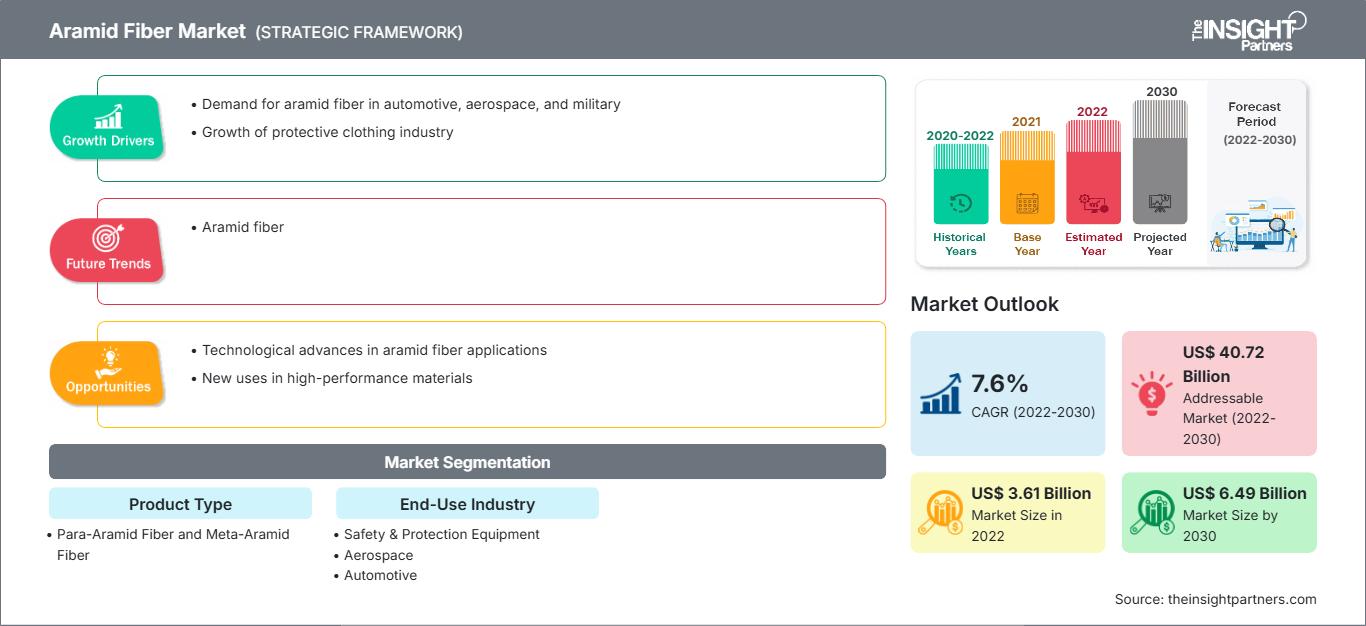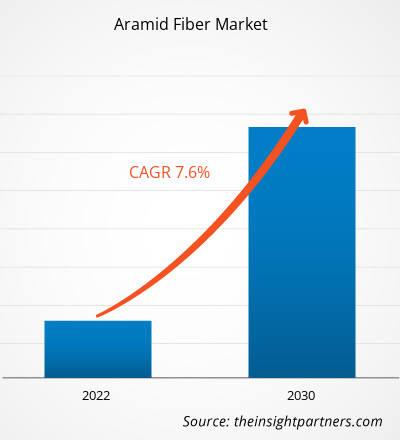[Informe de investigación] El tamaño del mercado de fibra de aramida se valoró en US$ 3.61 mil millones en 2022 y se espera que alcance los US$ 6.49 mil millones para 2030; se estima que registrará una CAGR del 7,6% de 2022 a 2030.
Perspectivas del mercado y opinión de los analistas:
Las fibras de aramida, también conocidas como poliamidas aromáticas, son fibras sintéticas con una resistencia, resistencia térmica y durabilidad excepcionales. Son reconocidas por su alta resistencia a la tracción, de cinco a seis veces mayor que la del acero, y su ligereza, con un peso de tan solo una quinta parte del acero. Estas extraordinarias propiedades las hacen valiosas para una amplia gama de aplicaciones, especialmente en industrias que exigen alto rendimiento y seguridad. La estructura única de las fibras de aramida contribuye significativamente a sus excepcionales propiedades. Estas fibras consisten en largas cadenas de moléculas de poliamida, donde los enlaces amida están directamente unidos a anillos aromáticos. Esta disposición da como resultado una estructura rígida, similar a una varilla, que confiere a las fibras una resistencia y rigidez excepcionales. Además, los anillos aromáticos proporcionan resistencia térmica y estabilidad inherentes, lo que permite que estas fibras soporten altas temperaturas sin una degradación significativa.
Factores impulsores del crecimiento y desafíos:
La creciente demanda de la industria automotriz ha sido un factor clave en la expansión del mercado de la fibra de aramida. La demanda de estas fibras ha aumentado exponencialmente a medida que los fabricantes de automóviles se centran cada vez más en la producción de vehículos más ligeros y de mayor eficiencia de combustible. La alta relación resistencia-peso de estas fibras, en particular las variantes de para-aramida, como el Kevlar, permite el desarrollo de componentes ligeros sin comprometer la integridad estructural. En el sector automotriz, estas fibras se utilizan ampliamente en diversas aplicaciones, como la fabricación de neumáticos, frenos, pastillas y materiales compuestos. El refuerzo de estos componentes con estas fibras mejora su durabilidad y resistencia al desgaste, lo que contribuye a una mayor vida útil y un mejor rendimiento general. Además, estas fibras se utilizan en la producción de compuestos para automóviles, proporcionando un equilibrio entre resistencia y peso crucial para alcanzar los objetivos de eficiencia de combustible. Por lo tanto, todos estos factores impulsan la demanda de fibras de aramida en el sector automotriz.
Sin embargo, el mercado de la fibra de aramida enfrenta limitaciones de crecimiento debido a la disponibilidad de sustitutos que ofrecen propiedades similares o alternativas. La fibra de carbono es uno de los principales sustitutos de estas fibras, que comparte algunas características con las fibras de aramida, como su alta resistencia y ligereza. En ciertas aplicaciones, los fabricantes pueden optar por la fibra de carbono como alternativa, especialmente cuando buscan materiales con mayor rigidez o conductividad. Esta competencia de sustitutos dificulta la adopción generalizada de estas fibras, sobre todo en industrias donde ambos materiales podrían cumplir con las especificaciones requeridas.
Obtendrá personalización en cualquier informe, sin cargo, incluidas partes de este informe o análisis a nivel de país, paquete de datos de Excel, así como también grandes ofertas y descuentos para empresas emergentes y universidades.
Mercado de fibra de aramida: Perspectivas estratégicas

- Obtenga las principales tendencias clave del mercado de este informe.Esta muestra GRATUITA incluirá análisis de datos, desde tendencias del mercado hasta estimaciones y pronósticos.
Segmentación y alcance del informe:
El "Análisis del Mercado Global de Fibra de Aramida hasta 2030" es un estudio especializado y exhaustivo centrado en las tendencias del mercado y las oportunidades de crecimiento a nivel mundial. El informe busca ofrecer una visión general del mercado con una segmentación detallada por tipo de producto e industria de uso final. El mercado ha experimentado un alto crecimiento en los últimos años y se prevé que esta tendencia continúe durante el período de pronóstico. El informe proporciona estadísticas clave sobre el consumo de fibra de aramida a nivel mundial. Además, ofrece una evaluación cualitativa de diversos factores que afectan el rendimiento del mercado de fibra de aramida a nivel mundial. El informe también incluye un análisis exhaustivo de los principales actores del mercado y sus principales desarrollos estratégicos. Se incluyen diversos análisis de la dinámica del mercado para ayudar a identificar los factores impulsores clave, las tendencias del mercado y las oportunidades lucrativas que, a su vez, ayudarán a identificar las principales fuentes de ingresos.
El análisis del ecosistema y el análisis de las cinco fuerzas de Porter proporcionan una visión de 360 grados del mercado, que ayuda a comprender toda la cadena de suministro y varios factores que afectan el crecimiento del mercado global de fibra de aramida.
Análisis segmentario:
Según el tipo de producto, el mercado se divide en fibra de para-aramida y fibra de meta-aramida. En cuanto a la industria de uso final, el mercado se segmenta en equipos de seguridad y protección, aeroespacial, automotriz, electrónica y telecomunicaciones, entre otros. El segmento de equipos de seguridad y protección registró una importante participación de mercado de fibra de aramida en 2022. Las fibras de aramida, en particular las variantes de para-aramida como el kevlar, son reconocidas por su excepcional resistencia, alto módulo y resistencia al impacto, lo que las hace ideales para aplicaciones donde la seguridad y la protección son primordiales. Esta fibra se utiliza ampliamente en la fabricación de chalecos y cascos balísticos. Su inherente resistencia balística, junto con su ligereza, las convierte en la opción preferida para chalecos antibalas. Las fuerzas militares y policiales de todo el mundo utilizan ampliamente equipos de protección a base de aramida para brindar al personal una protección eficaz contra amenazas balísticas sin comprometer la movilidad. Todos estos factores impulsan el mercado de la fibra de aramida en el segmento de equipos de seguridad y protección.
Análisis regional:
Según la geografía, el mercado de la fibra de aramida se segmenta en cinco regiones clave: Norteamérica, Europa, Asia Pacífico, Sudamérica y Centroamérica, y Oriente Medio y África. El mercado estuvo dominado por Asia Pacífico, que representó aproximadamente US$1.000 millones en 2022. La región ofrece numerosas oportunidades de crecimiento. El aumento de la inversión extranjera directa también impulsa el crecimiento económico de la región. Se prevé que el creciente uso de estas fibras en numerosas aplicaciones, como autopartes, electrónica y otras, aumente la demanda de fibra de aramida en Asia Pacífico.
Se espera que Europa registre una tasa de crecimiento anual compuesta (TCAC) superior al 8,0 % entre 2022 y 2030. Las fibras de aramida son cruciales para la fabricación de componentes ligeros y robustos en estructuras aeronáuticas y sistemas de protección balística. Dado que Europa alberga empresas aeroespaciales líderes y un importante sector de defensa, la demanda de fibras de aramida en estas industrias sigue en aumento. Además, se espera que América del Norte alcance unos 1700 millones de dólares estadounidenses en 2030.
Desarrollos de la industria y oportunidades futuras:
A continuación se enumeran diversas iniciativas adoptadas por los actores clave que operan en el mercado de fibra de aramida:
- En abril de 2023, DuPont de Nemours Inc. anunció el lanzamiento de la fibra de aramida Kevlar EXOTM. Kevlar EXO ofrecerá una combinación de ligereza, flexibilidad y protección, siendo la protección de la vida el primero de muchos usos.
Perspectivas regionales del mercado de fibra de aramida
Los analistas de The Insight Partners han explicado detalladamente las tendencias regionales y los factores que influyen en el mercado de la fibra de aramida durante el período de pronóstico. Esta sección también analiza los segmentos y la geografía del mercado de la fibra de aramida en América del Norte, Europa, Asia Pacífico, Oriente Medio y África, y América del Sur y Central.
Alcance del informe de mercado de fibra de aramida
| Atributo del informe | Detalles |
|---|---|
| Tamaño del mercado en 2022 | US$ 3.61 mil millones |
| Tamaño del mercado en 2030 | US$ 6.49 mil millones |
| CAGR global (2022-2030) | 7,6% |
| Datos históricos | 2020-2022 |
| Período de pronóstico | 2022-2030 |
| Segmentos cubiertos | Por tipo de producto
|
| Regiones y países cubiertos | América del norte
|
| Líderes del mercado y perfiles de empresas clave |
|
Densidad de los actores del mercado de fibra de aramida: comprensión de su impacto en la dinámica empresarial
El mercado de la fibra de aramida está creciendo rápidamente, impulsado por la creciente demanda del usuario final debido a factores como la evolución de las preferencias de los consumidores, los avances tecnológicos y un mayor conocimiento de los beneficios del producto. A medida que aumenta la demanda, las empresas amplían su oferta, innovan para satisfacer las necesidades de los consumidores y aprovechan las tendencias emergentes, lo que impulsa aún más el crecimiento del mercado.

- Obtenga una descripción general de los principales actores clave del mercado de fibra de aramida
Impacto del COVID-19:
La pandemia de COVID-19 afectó negativamente a casi todas las industrias en varios países. Los confinamientos, las restricciones de viaje y los cierres de empresas en América del Norte, Europa, Asia Pacífico (APAC), América del Sur y Central, y Oriente Medio y África (MEA) obstaculizaron el crecimiento de varias industrias, incluida la industria química y de materiales. El cierre de las unidades de fabricación de las empresas de fibras de aramida perturbó las cadenas de suministro globales, las actividades de fabricación y los plazos de entrega. Varias empresas informaron retrasos en las entregas de productos y una caída en sus ventas en 2020. La mayoría de las instalaciones de fabricación industrial cerraron durante la pandemia, lo que disminuyó el consumo de estas fibras. Además, la pandemia de COVID-19 ha provocado fluctuaciones en los precios de la fibra de aramida. Sin embargo, varias industrias reanudaron sus operaciones después de que se resolvieran las restricciones de suministro, lo que llevó a una reactivación del mercado de contenedores de plástico. Además, la creciente demanda de estas fibras por parte de la industria automotriz está impulsando sustancialmente el crecimiento del mercado de la fibra de aramida.
Panorama competitivo y empresas clave:
DuPont de Nemours Inc., Teijin Limited, Yantai Tayho Advanced Materials Company, Hyosung Corporation, Toray Industries Inc., Kolon Industries, Huvis Corporation, China National Bluestar (Group) Co. Ltd., Taekwang Industrial Co. Ltd. y Kermel SAS se encuentran entre los principales actores del mercado global de fibra de aramida. Estos actores se centran en ofrecer productos de alta calidad para satisfacer la demanda de los clientes.
- Análisis histórico (2 años), año base, pronóstico (7 años) con CAGR
- Análisis PEST y FODA
- Tamaño del mercado, valor/volumen: global, regional y nacional
- Industria y panorama competitivo
- Conjunto de datos de Excel
Informes recientes
Informes relacionados
Testimonios
Razón para comprar
- Toma de decisiones informada
- Comprensión de la dinámica del mercado
- Análisis competitivo
- Información sobre clientes
- Pronósticos del mercado
- Mitigación de riesgos
- Planificación estratégica
- Justificación de la inversión
- Identificación de mercados emergentes
- Mejora de las estrategias de marketing
- Impulso de la eficiencia operativa
- Alineación con las tendencias regulatorias






















 Obtenga una muestra gratuita para - Mercado de fibra de aramida
Obtenga una muestra gratuita para - Mercado de fibra de aramida